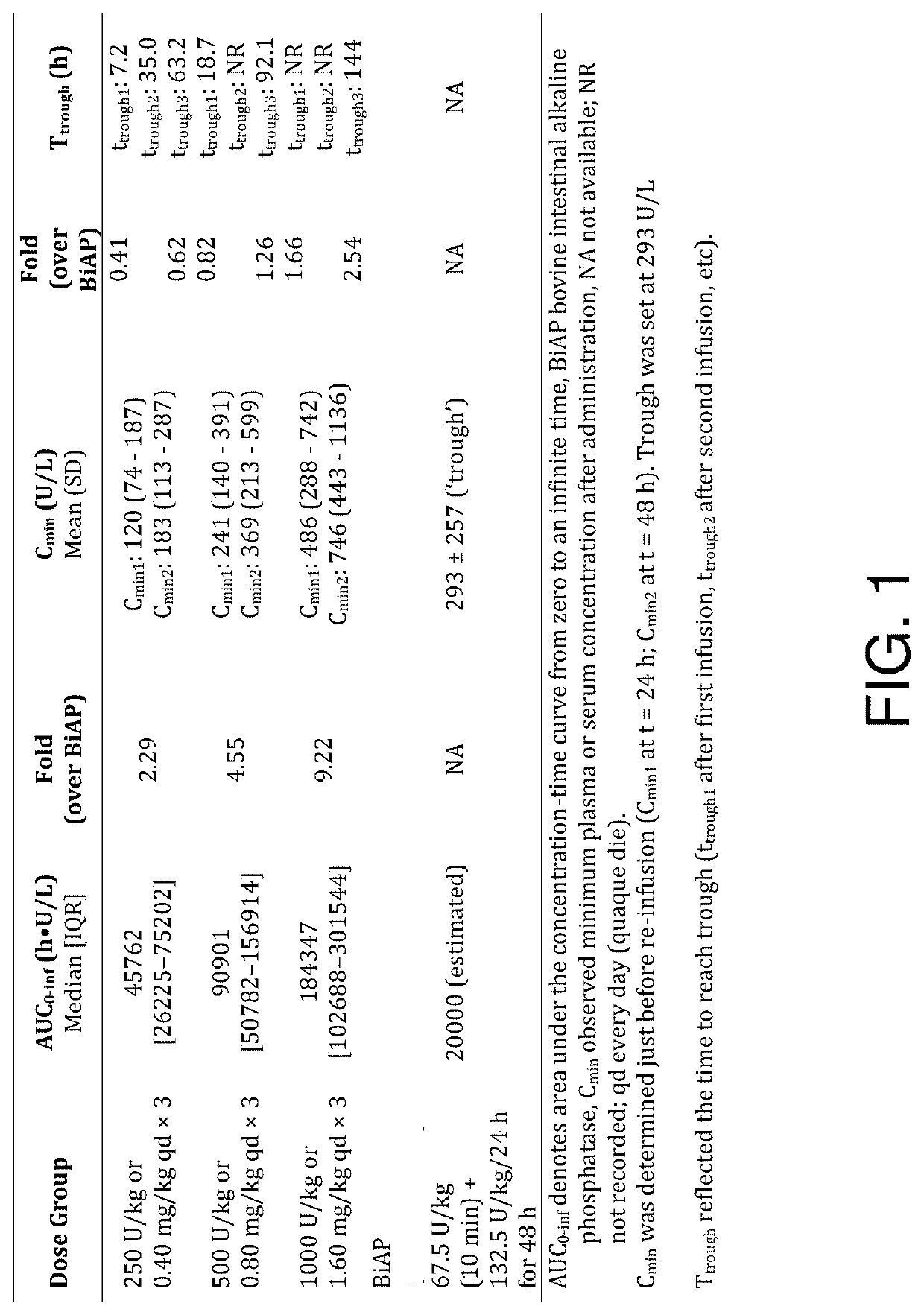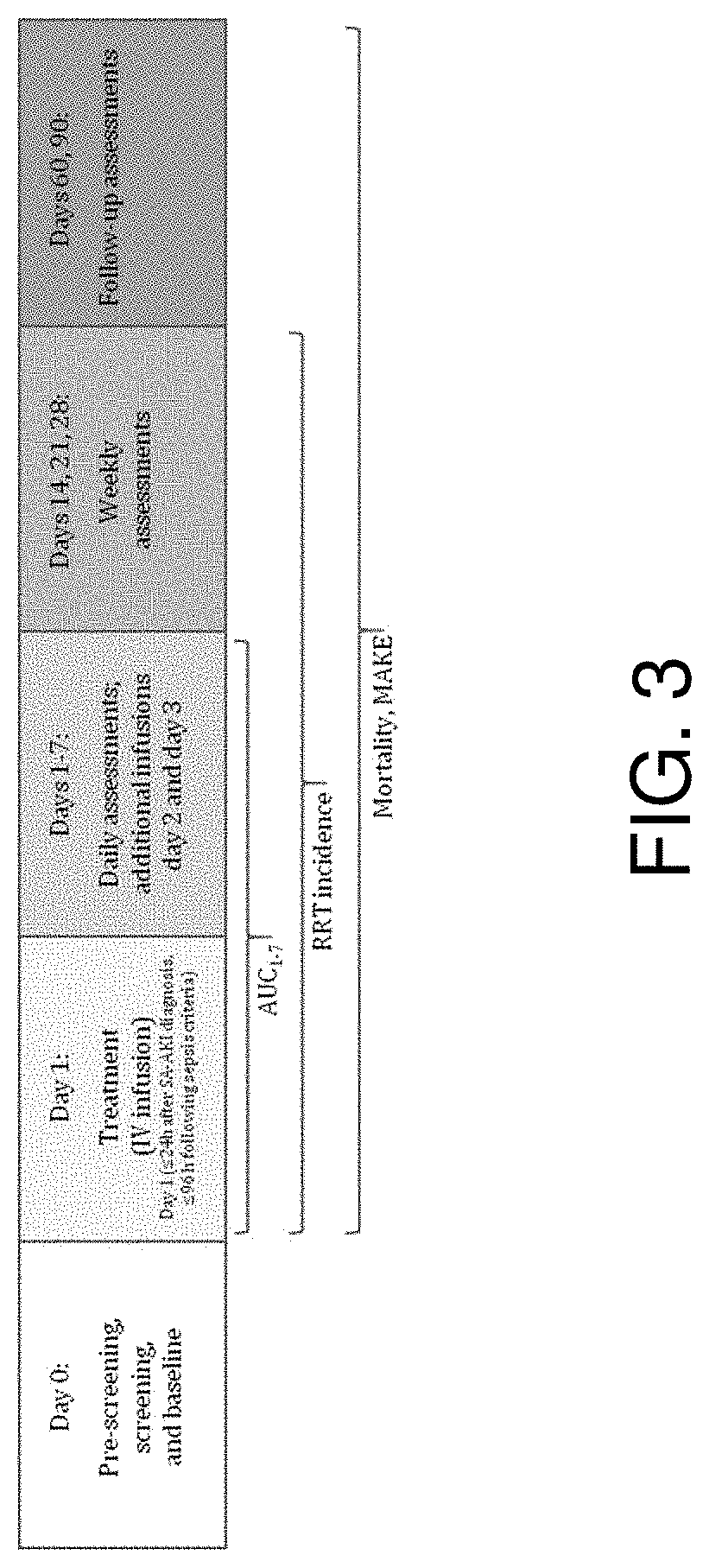Recombinant alkaline phosphatase for use in treating sepsis-associated acute kidney injury
a technology of sepsis and recombinant alkaline phosphatase, which is applied in the direction of peptide/protein ingredients, drug compositions, enzymology, etc., can solve the problems of increased mortality, acute kidney injury (aki), and association of aki in sepsis patients, and achieve the effect of shortening the duration or cessation of renal replacement therapy
- Summary
- Abstract
- Description
- Claims
- Application Information
AI Technical Summary
Benefits of technology
Problems solved by technology
Method used
Image
Examples
example 1
Human recombinant Alkaline Phosphatase for Sepsis-Associated Acute Kidney Injury
[0278]Sepsis-associated acute kidney injury (AKI) adversely affects long-term renal outcomes and survival. Administration of the detoxifying enzyme alkaline phosphatase improved renal function and survival in preclinical studies. We investigated the efficacy and safety of a human recombinant alkaline phosphatase (RecAP) (FIG. 2) in patients with sepsis-associated AKI.
[0279]In Part 1 of the adaptive phase 2a / 2b STOP-AKI trial, patients were randomized to receive RecAP 0.4, 0.8, or 1.6 mg / kg, or placebo, once daily for 3 days to establish the optimal dose.
[0280]In Part 2, this dose was compared with placebo. The primary endpoint was time-corrected area under the curve of the endogenous creatinine clearance for days 1-7 (AUC1-7
[0281]ECC), with renal replacement therapy (RRT) as a key secondary endpoint. Longer-term renal function, major adverse kidney events (MAKE) on days 28, 60, and 90, and survival were...
example 2
Determination of RecAP Enzyme Activity and Protein Concentration
[0435]Activity Assay:
[0436]Determination of recAP enzyme activity was based on the conversion (hydrolysis) of 4-nitrophenolphosphate into 4-nitrophenol which is colored yellow. The change in optical density at 405nm per unit time is a measure for the alkaline phosphatase activity. The assay buffer consisted of 0.25M Glycine buffer pH 9.6 at 25° C. with 2mM MgCl2 and 0.1 mM ZnCl2 and 8.5mM 4-nitrophenolphosphate.
[0437]The unit (U) definition for recAP, expressed as U / mL, is the amount of enzyme causing the hydrolysis of 1 μmol of 4-nitrophenolphosphate per minute at pH 9.6 and 25° C.
[0438]Protein Concentration:
[0439]Determination of total protein concentration in RecAP Drug Substance and Drug Product was performed by UV / Vis analysis. A RecAP solution is analysed at 280nm and the absorbance is a measure for protein content (mg / mL) using the formula:
Concentration (mg / mL)=[A / (a×b)]×DF with A=A280; b=path length; a=mass exti...
PUM
| Property | Measurement | Unit |
|---|---|---|
| concentration | aaaaa | aaaaa |
| concentration | aaaaa | aaaaa |
| pressure | aaaaa | aaaaa |
Abstract
Description
Claims
Application Information
 Login to View More
Login to View More - R&D
- Intellectual Property
- Life Sciences
- Materials
- Tech Scout
- Unparalleled Data Quality
- Higher Quality Content
- 60% Fewer Hallucinations
Browse by: Latest US Patents, China's latest patents, Technical Efficacy Thesaurus, Application Domain, Technology Topic, Popular Technical Reports.
© 2025 PatSnap. All rights reserved.Legal|Privacy policy|Modern Slavery Act Transparency Statement|Sitemap|About US| Contact US: help@patsnap.com



